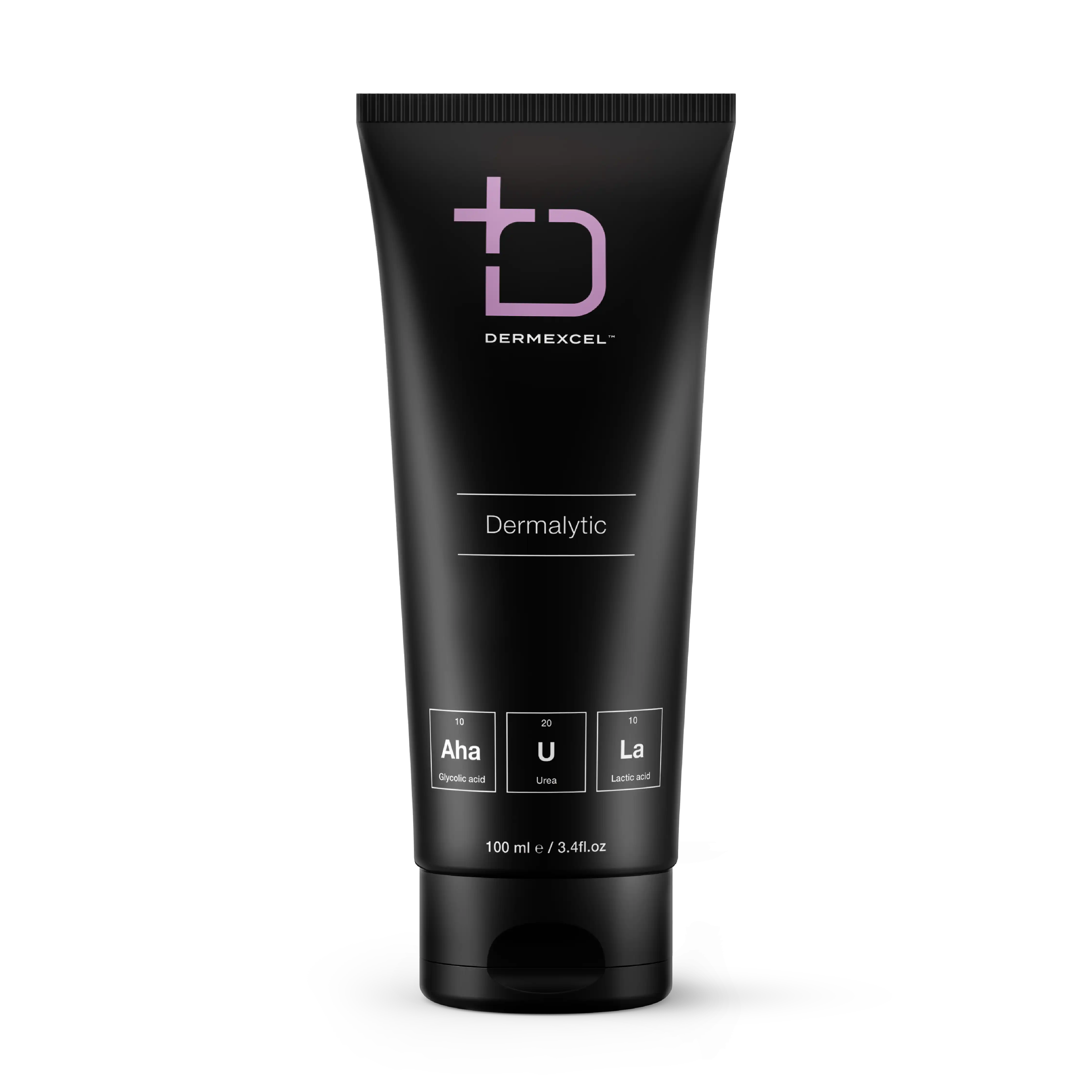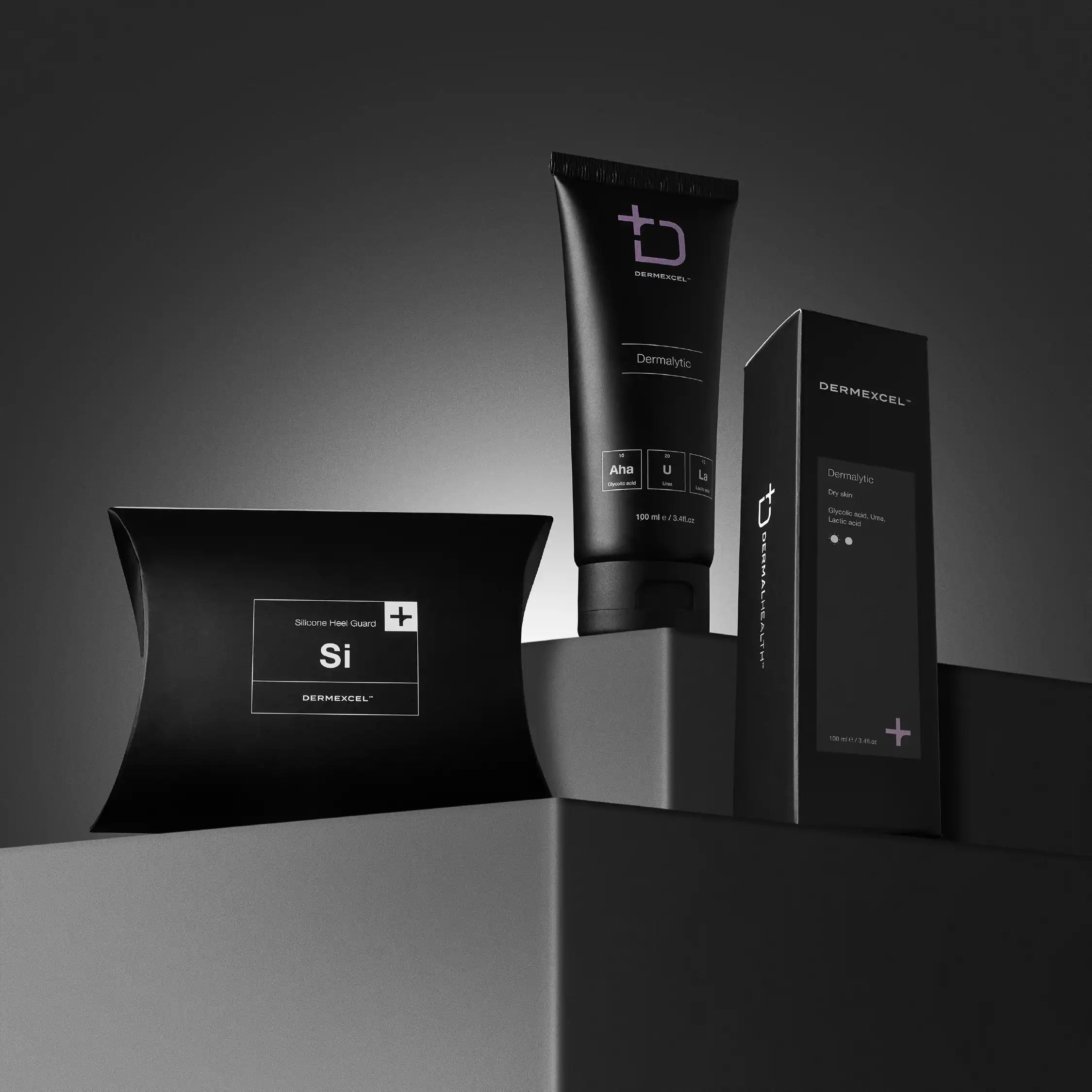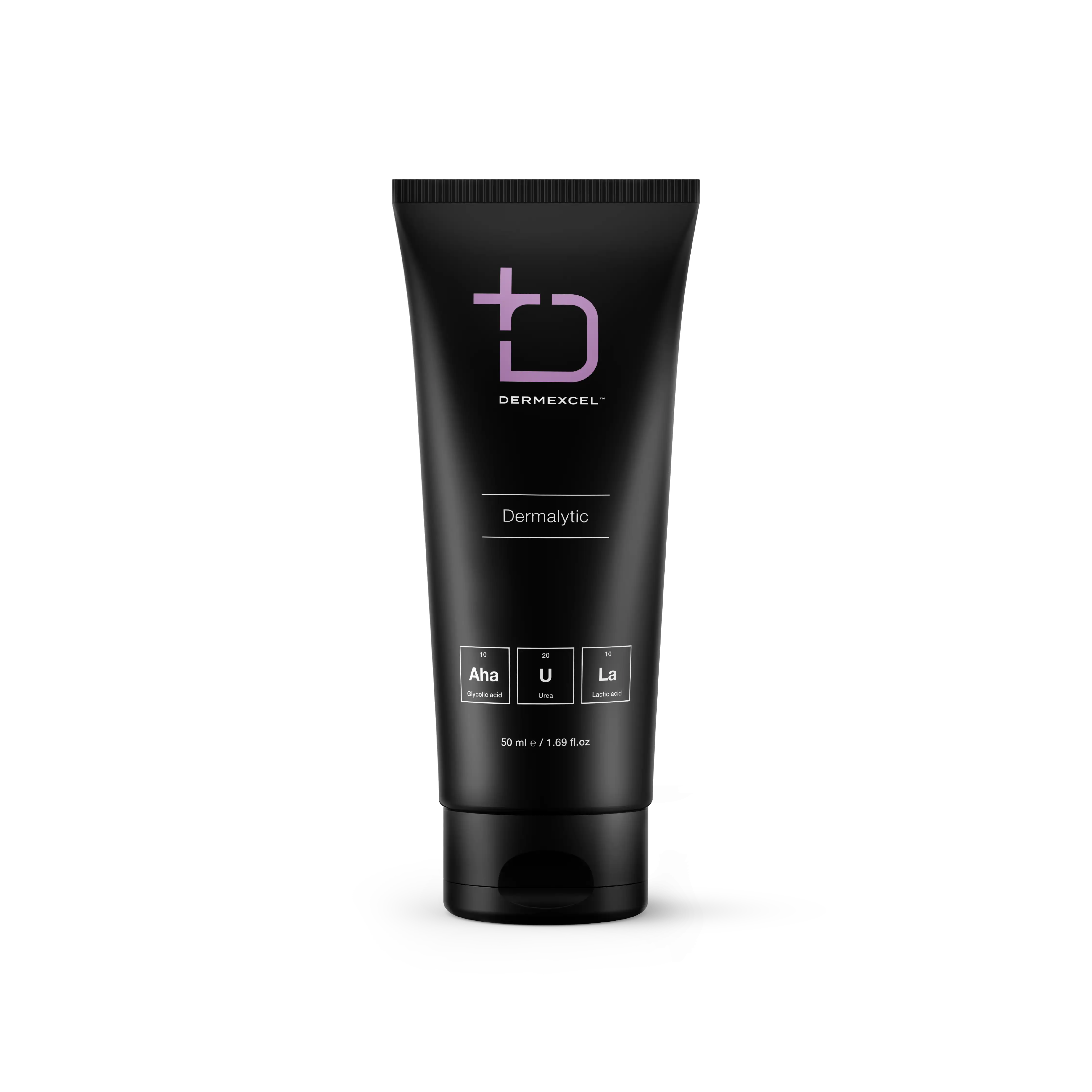






Keratolytic Treatment
Pay interest-free installments from R 72.17 with various payment gateways selected at checkout.

Ingrown hair

Body Acne

Keratosis Pilaris

Rough Skin

cracked heels
A potent and clinically formulated ointment that effectively treats calloused, rough, and dry skin. It's more than a standard moisturizer; it exfoliates dead skin cells and replenishes moisture. The product creates an optimal environment for skin health, leading to a smoother complexion.
Key ingredients include 10% Glycolic acid for exfoliation, 10% Lactic acid for removing dead cells, and 20% Urea for lasting hydration. Its "cream-ointment" base balances efficacy and application comfort. Dermalytic's medical-grade formula and scientific skincare approach visibly improve skin texture, giving users a renewed sense of confidence and comfort.
Note: Dermalytic is too potent for facial use.
Glycolic acid
Glycolic acid is highly acclaimed for its remarkable exfoliating and rejuvenating properties. Its small molecular size enables deep skin penetration, fostering efficient exfoliation at the cellular level.
Glycolic acid’s water solubility allows it to penetrate the upper layers of the skin easily. Its primary mechanism of action involves weakening the bonds between dead skin cells, promoting their shedding, and revealing the newer, healthier skin beneath. This process of accelerated cell turnover is instrumental in addressing a range of skin concerns, from aging signs like fine lines and wrinkles to texture irregularities and hyperpigmentation.
Glycolic acid's efficacy extends beyond mere exfoliation. It's also recognized for stimulating collagen production, a crucial protein in maintaining skin's elasticity and firmness. This aspect contributes to its anti-aging benefits. Furthermore, its hydrating properties add to its appeal, as they help increase the skin's capacity to retain moisture, leading to a more supple and vibrant complexion.
Clinical studies have consistently supported glycolic acid's role in improving skin appearance. Research indicates significant improvements in skin texture and pigmentation and the visible reduction of wrinkles and fine lines with glycolic acid.
Physiological Effects
- Exfoliation: Glycolic acid is a powerful exfoliant. It dissolves the bonds between dead skin cells on the skin’s surface, facilitating their removal and revealing newer, healthier skin underneath.
- Increased Collagen Production: It stimulates collagen production, which is essential for skin elasticity and firmness. This action helps reduce the appearance of fine lines and wrinkles.
- Enhanced Skin Hydration: Glycolic acid improves the skin's ability to retain moisture, enhancing hydration and a more plump, vibrant skin appearance.
- Skin Brightening: Removing dead skin cells can brighten the complexion and reduce the appearance of dark spots and hyperpigmentation.
- Improved Skin Texture: Regular use of glycolic acid can lead to smoother, more even textured skin, making it beneficial for conditions like keratosis pilaris.
- Acne Treatment: Its exfoliating properties help in unclogging pores, thereby reducing the occurrence of acne breakouts.
Managing Dermatological Conditions
- Aging Skin: Glycolic acid is widely used in anti-aging products to reduce signs of aging, such as fine lines, wrinkles, and age spots.
- Acne-Prone Skin: It helps manage acne by exfoliating the skin and removing blockage from pores.
- Hyperpigmentation: It effectively treats hyperpigmentation by accelerating the removal of hyperpigmented skin cells.
- Textural Irregularities: Glycolic acid can improve skin texture and is beneficial for treating keratosis pilaris and other conditions of rough skin.
- Sun-Damaged Skin: It helps rejuvenate sun-damaged skin by accelerating cell turnover and collagen synthesis.
References
- Bernstein, E. F. (2001). Glycolic acid treatment increases type I collagen mRNA and hyaluronic acid content of human skin. Dermatologic Surgery.
- Kornhauser, A., Coelho, S. G., & Hearing, V. J. (2010). Applications of hydroxy acids: classification, mechanisms, and photoactivity. Clinical, Cosmetic and Investigational Dermatology.
- Sharad, J. (2013). Glycolic acid peel therapy – a current review. Clinical, Cosmetic and Investigational Dermatology.
- Smith, W. P. (1996). Epidermal and dermal effects of topical lactic acid. Journal of the American Academy of Dermatology, 35(3), 388-391.
Urea
Urea, a naturally occurring compound in the skin, is widely recognized in dermatology and skin care for its hydrating and keratolytic properties. It is a component of the skin's natural moisturizing factor (NMF) and is crucial in maintaining skin hydration and barrier function.
In skin care, urea is valued for its dual action: it acts as a humectant, drawing moisture into the skin, and as a keratolytic agent, helping to break down the protein bonds between dead skin cells, leading to smoother and softer skin. This makes it particularly effective in treating dry, rough, and scaly skin conditions such as eczema, psoriasis, and ichthyosis.
Additionally, urea has been shown to have antimicrobial properties and can aid in skin barrier repair, further underscoring its utility in treating various skin conditions.
Physiological Effects
- Hydration: Urea is a potent humectant, meaning it draws moisture into the skin, significantly improving hydration and maintaining skin moisture balance.
- Keratolytic Action: Urea has keratolytic properties, helping to break down the bonds between dead skin cells and aiding in the exfoliation of the skin's surface.
- Skin Barrier Function: Urea enhances the skin's barrier function, helping to prevent moisture loss and protect the skin from external irritants.
- Soothing Effect: It soothes dry, itchy, and irritated skin, providing relief from various skin conditions.
Managing Dermatological Conditions
- Dry Skin (Xerosis): Urea is a key ingredient in many moisturizers for treating dry skin due to its excellent hydrating properties.
- Eczema and Psoriasis: It helps manage symptoms like dryness, scaling, and itching in eczema and psoriasis.
- Ichthyosis and Keratosis Pilaris: The keratolytic action of urea makes it effective in conditions characterized by excessive skin scaling, such as ichthyosis and keratosis pilaris.
- Cracked Heels and Calluses: Urea-based creams effectively soften and reduce thickened skin on heels and calluses.
- Aging Skin: It can improve skin texture and hydration in aging skin.
References
- Lodén, M. (2003). Role of topical emollients and moisturizers in the treatment of dry skin barrier disorders. American Journal of Clinical Dermatology.
- Pan, M., et al. (2013). Efficacy of topical urea in the treatment of xerosis. American Journal of Clinical Dermatology.
- Fluhr, J. W., et al. (2008). Glycerol and the skin: holistic approach to its origin and functions. British Journal of Dermatology.
- Grether-Beck, S., Felsner, I., Brenden, H., Kohne, Z., Majora, M., Marini, A., ... & Krutmann, J. (2012). Urea uptake enhances barrier function and antimicrobial defense in humans by regulating epidermal gene expression. Journal of Investigative Dermatology, 132(6), 1561-1572.
Lactic acid
Lactic acid, a member of the alpha hydroxy acid (AHA) family, is a well-regarded ingredient in the field of dermatology and skincare for its exfoliating and moisturizing properties. Naturally occurring in sour milk and other fermented products, lactic acid is also produced in the human body and plays a role in various metabolic processes.
In skincare, lactic acid is primarily known for its ability to exfoliate the skin gently. By breaking down the bonds that hold dead skin cells together on the skin's surface, lactic acid helps to promote the shedding of these cells, revealing fresher, brighter skin underneath. This exfoliation process improves skin texture and tone and stimulates cell renewal.
One key advantage of lactic acid over other AHAs is its moisturizing capability. Lactic acid helps increase the skin's natural moisturizing factors (NMF), essential for keeping the skin hydrated. Its unique ability to draw moisture into the skin is particularly beneficial for treating dry and dehydrated skin conditions.
Physiological Effects
- Exfoliation: A gentle exfoliant that removes dead skin cells from the skin's surface, promoting smooth skin.
- Moisture Retention: It is a humectant that helps the skin retain moisture, improving hydration and reducing dryness.
- Collagen Stimulation: Lactic acid can stimulate collagen production in the deeper layers of the skin, aiding in skin firmness and reducing the appearance of fine lines and wrinkles.
- Skin Brightening: It helps lighten dark spots and even out skin tone, effectively treating hyperpigmentation.
- pH Balancing: Lactic acid can help balance the skin's natural pH levels, which is beneficial for maintaining a healthy skin barrier.
Managing Dermatological Conditions
- Aging Skin: Lactic acid's collagen-stimulating and exfoliating properties make it effective in anti-aging treatments, reducing signs of aging like wrinkles and age spots.
- Acne-Prone Skin: By unclogging pores and removing dead skin cells, lactic acid can help reduce acne breakouts.
- Dry Skin (Xerosis): Its humectant properties are beneficial in hydrating and relieving dry skin.
- Hyperpigmentation: Lactic acid treats hyperpigmentation issues, including melasma and sun damage.
- Keratosis Pilaris: It can help manage keratosis pilaris by exfoliating the excess keratin that blocks hair follicles.
References
- Smith, W. P. (1996). Epidermal and dermal effects of topical lactic acid. Journal of the American Academy of Dermatology.
- Kornhauser, A., Coelho, S. G., & Hearing, V. J. (2010). Applications of hydroxy acids: classification, mechanisms, and photoactivity. Clinical, Cosmetic and Investigational Dermatology.
- Stiller, M. J., et al. (1996). Topical 8% glycolic acid and 8% L-lactic acid creams for the treatment of photodamaged skin. A double-blind vehicle-controlled clinical trial. Archives of Dermatology.
- Rawlings, A. V., Davies, A., Carlomusto, M., Pillai, S., Zhang, K., Kosturko, R., ... & Watson, D. (1996). Effect of lactic acid isomers on keratinocyte ceramide synthesis, stratum corneum lipid levels and stratum corneum barrier function. Archives of Dermatological Research, 288(7), 383-390.




SHIPPING
- Shipping Guarantee: Guiding you to healthy skin isn’t only about our products; it's also about getting them to you as swiftly as the science behind them. That's why Dermal Health offers a shipping guarantee you can rely on.
- Where We Ship From: Orders are dispatched from our facilities in Pretoria.
- Who We Ship With: We trust only well-known, popular, and dependable courier services with your packages.
- When You'll Get It: Expect confident skin soon! Shipping addresses in Pretoria and Johannesburg will enjoy delivery from same-day to 2 business days. Shipping addresses further from Pretoria may expect delivery within 1-4 business days, depending on the service you select during checkout. Your estimated delivery date will reflect during checkout so that you can mark your calendar.
- Tracking Your Order: Eager to start your DermExcel journey? We don't blame you! You'll receive a tracking number after you place your order so that you can follow your package.
For any shipping inquiries, our customer service team is ready to assist.
RETURNS
We are passionate about guiding you to healthier skin through medical science. We believe in the quality and proven effectiveness of our formulations — and we’re committed to supporting you on your journey to real, visible results.
That’s why we offer a 30-Day Confidence Guarantee. If, after consistent use as directed, you genuinely feel that your skin has not improved in any meaningful way — and you can demonstrate this (for example, with before-and-after photos or a brief description of your experience) — you’re welcome to request a return within 30 days of receiving your order, in line with our return policy.
Healthy skin is not complicated — and neither is our return process. To view the full terms, please visit our detailed return policy or contact our friendly customer care team. We’re here to help.
Feel as confident in us as we want you to feel in your skin.
SECURE PAYMENT
Dermal Health Science 30-Day Confidence Guarantee: We are passionate about guiding you to healthy skin through medical science. We believe in the quality and effectiveness of our products so much that we offer a 30-Day Confidence Guarantee.
If you're unsatisfied with your purchase, simply return it within 30 days for a full refund.
Healthy Skin Is Not Complicated and neither is our return policy. Please visit our detailed return policy or contact our friendly customer service team for more information.
Feel as confident in us as we want you to feel in your skin.
Free Gift with Dermalytic:

Silicone Heel Guards

Choose options
- Corns and Calluses: These are thick, hardened layers of skin that develop when your skin tries to protect itself against friction and pressure. Dermalytic softens and exfoliates thickened skin areas, commonly found on hands and feet.
- Dry Skin (Xerosis): Restore moisture to dry skin and improve its texture and appearance.
- Keratosis Pilaris: Manage this condition, characterized by rough, small bumps on the skin.
- Ichthyosis vulgaris: A genetic skin disorder causing dry, scaly skin—the keratolytic properties of Dermalytic help to alleviate the symptoms.
- Psoriasis: A chronic skin condition that causes cells to build up rapidly on the surface of the skin, forming scales and red patches that are sometimes painful. Dermalytic's keratolytic properties help to soften and remove these scales.
- Actinic keratosis: A rough, scaly patch on the skin that develops from years of exposure to the sun. The exfoliating and moisturizing action of Dermalytic is beneficial in managing this condition.
- Rough skin and uneven skin tone: Stimulates cellular turnover, improving skin texture and even skin tone.
- Aging and sun-damaged skin: Exfoliate and stimulate new skin cell production and collagen synthesis.
- Shaving Bumps and Ingrown Hair on the Body: Soothe shaving bumps and prevent ingrown hairs by exfoliating the skin and preventing pore clogging.
Apply as often as needed on areas of concern for targeted treatment.
Areas with Body Acne
Back and Chest
- Start by applying twice weekly.
- Slowly increase the frequency of use as tolerated by your skin.
Areas with ingrown hair bumps
Legs, bikini-line, neck etc.
- Start by applying twice weekly.
- Slowly increase the frequency of use as tolerated by your skin.
- For the bikini-line: Apply a minimal amount, and observe how your skin reacts before increasing frequency of use.
Areas with dry, cracked, or hardened skin
Heels, Elbows, and Knees
- Apply Dermalytic every evening as tolerated by your skin.
- Wear heel guards to cover the area for at least an hour or overnight.
Important note
- Do not apply Dermalytic on your face. Dermalytic is too potent for facial use.
- Always apply SPF 30 or above during the day to areas not covered by your clothes.
Active ingredients
- Exfoliation: Glycolic acid is a powerful exfoliant. It dissolves the bonds between dead skin cells on the skin’s surface, facilitating their removal and revealing newer, healthier skin underneath.
- Increased Collagen Production: It stimulates collagen production, which is essential for skin elasticity and firmness. This action helps reduce the appearance of fine lines and wrinkles.
- Enhanced Skin Hydration: Glycolic acid improves the skin's ability to retain moisture, enhancing hydration and a more plump, vibrant skin appearance.
- Skin Brightening: Removing dead skin cells can brighten the complexion and reduce the appearance of dark spots and hyperpigmentation.
- Improved Skin Texture: Regular use of glycolic acid can lead to smoother, more even textured skin, making it beneficial for conditions like keratosis pilaris.
- Acne Treatment: Its exfoliating properties help in unclogging pores, thereby reducing the occurrence of acne breakouts.
- Aging Skin: Glycolic acid is widely used in anti-aging products to reduce signs of aging, such as fine lines, wrinkles, and age spots.
- Acne-Prone Skin: It helps manage acne by exfoliating the skin and removing blockage from pores.
- Hyperpigmentation: It effectively treats hyperpigmentation by accelerating the removal of hyperpigmented skin cells.
- Textural Irregularities: Glycolic acid can improve skin texture and is beneficial for treating keratosis pilaris and other conditions of rough skin.
- Sun-Damaged Skin: It helps rejuvenate sun-damaged skin by accelerating cell turnover and collagen synthesis.
- Bernstein, E. F. (2001). Glycolic acid treatment increases type I collagen mRNA and hyaluronic acid content of human skin. Dermatologic Surgery.
- Kornhauser, A., Coelho, S. G., & Hearing, V. J. (2010). Applications of hydroxy acids: classification, mechanisms, and photoactivity. Clinical, Cosmetic and Investigational Dermatology.
- Sharad, J. (2013). Glycolic acid peel therapy – a current review. Clinical, Cosmetic and Investigational Dermatology.
- Smith, W. P. (1996). Epidermal and dermal effects of topical lactic acid. Journal of the American Academy of Dermatology, 35(3), 388-391.
- Hydration: Urea is a potent humectant, meaning it draws moisture into the skin, significantly improving hydration and maintaining skin moisture balance.
- Keratolytic Action: Urea has keratolytic properties, helping to break down the bonds between dead skin cells and aiding in the exfoliation of the skin's surface.
- Skin Barrier Function: Urea enhances the skin's barrier function, helping to prevent moisture loss and protect the skin from external irritants.
- Soothing Effect: It soothes dry, itchy, and irritated skin, providing relief from various skin conditions.
- Dry Skin (Xerosis): Urea is a key ingredient in many moisturizers for treating dry skin due to its excellent hydrating properties.
- Eczema and Psoriasis: It helps manage symptoms like dryness, scaling, and itching in eczema and psoriasis.
- Ichthyosis and Keratosis Pilaris: The keratolytic action of urea makes it effective in conditions characterized by excessive skin scaling, such as ichthyosis and keratosis pilaris.
- Cracked Heels and Calluses: Urea-based creams effectively soften and reduce thickened skin on heels and calluses.
- Aging Skin: It can improve skin texture and hydration in aging skin.
- Lodén, M. (2003). Role of topical emollients and moisturizers in the treatment of dry skin barrier disorders. American Journal of Clinical Dermatology.
- Pan, M., et al. (2013). Efficacy of topical urea in the treatment of xerosis. American Journal of Clinical Dermatology.
- Fluhr, J. W., et al. (2008). Glycerol and the skin: holistic approach to its origin and functions. British Journal of Dermatology.
- Grether-Beck, S., Felsner, I., Brenden, H., Kohne, Z., Majora, M., Marini, A., ... & Krutmann, J. (2012). Urea uptake enhances barrier function and antimicrobial defense in humans by regulating epidermal gene expression. Journal of Investigative Dermatology, 132(6), 1561-1572.
- Exfoliation: A gentle exfoliant that removes dead skin cells from the skin's surface, promoting smooth skin.
- Moisture Retention: It is a humectant that helps the skin retain moisture, improving hydration and reducing dryness.
- Collagen Stimulation: Lactic acid can stimulate collagen production in the deeper layers of the skin, aiding in skin firmness and reducing the appearance of fine lines and wrinkles.
- Skin Brightening: It helps lighten dark spots and even out skin tone, effectively treating hyperpigmentation.
- pH Balancing: Lactic acid can help balance the skin's natural pH levels, which is beneficial for maintaining a healthy skin barrier.
- Aging Skin: Lactic acid's collagen-stimulating and exfoliating properties make it effective in anti-aging treatments, reducing signs of aging like wrinkles and age spots.
- Acne-Prone Skin: By unclogging pores and removing dead skin cells, lactic acid can help reduce acne breakouts.
- Dry Skin (Xerosis): Its humectant properties are beneficial in hydrating and relieving dry skin.
- Hyperpigmentation: Lactic acid treats hyperpigmentation issues, including melasma and sun damage.
- Keratosis Pilaris: It can help manage keratosis pilaris by exfoliating the excess keratin that blocks hair follicles.
- Smith, W. P. (1996). Epidermal and dermal effects of topical lactic acid. Journal of the American Academy of Dermatology.
- Kornhauser, A., Coelho, S. G., & Hearing, V. J. (2010). Applications of hydroxy acids: classification, mechanisms, and photoactivity. Clinical, Cosmetic and Investigational Dermatology.
- Stiller, M. J., et al. (1996). Topical 8% glycolic acid and 8% L-lactic acid creams for the treatment of photodamaged skin. A double-blind vehicle-controlled clinical trial. Archives of Dermatology.
- Rawlings, A. V., Davies, A., Carlomusto, M., Pillai, S., Zhang, K., Kosturko, R., ... & Watson, D. (1996). Effect of lactic acid isomers on keratinocyte ceramide synthesis, stratum corneum lipid levels and stratum corneum barrier function. Archives of Dermatological Research, 288(7), 383-390.
Glycolic acid
Glycolic acid is highly acclaimed for its remarkable exfoliating and rejuvenating properties. Its small molecular size enables deep skin penetration, fostering efficient exfoliation at the cellular level.
Glycolic acid’s water solubility allows it to penetrate the upper layers of the skin easily. Its primary mechanism of action involves weakening the bonds between dead skin cells, promoting their shedding, and revealing the newer, healthier skin beneath. This process of accelerated cell turnover is instrumental in addressing a range of skin concerns, from aging signs like fine lines and wrinkles to texture irregularities and hyperpigmentation.
Glycolic acid's efficacy extends beyond mere exfoliation. It's also recognized for stimulating collagen production, a crucial protein in maintaining skin's elasticity and firmness. This aspect contributes to its anti-aging benefits. Furthermore, its hydrating properties add to its appeal, as they help increase the skin's capacity to retain moisture, leading to a more supple and vibrant complexion.
Clinical studies have consistently supported glycolic acid's role in improving skin appearance. Research indicates significant improvements in skin texture and pigmentation and the visible reduction of wrinkles and fine lines with glycolic acid.
Physiological Effects
Managing Dermatological Conditions
References
Urea
Urea, a naturally occurring compound in the skin, is widely recognized in dermatology and skin care for its hydrating and keratolytic properties. It is a component of the skin's natural moisturizing factor (NMF) and is crucial in maintaining skin hydration and barrier function.
In skin care, urea is valued for its dual action: it acts as a humectant, drawing moisture into the skin, and as a keratolytic agent, helping to break down the protein bonds between dead skin cells, leading to smoother and softer skin. This makes it particularly effective in treating dry, rough, and scaly skin conditions such as eczema, psoriasis, and ichthyosis.
Additionally, urea has been shown to have antimicrobial properties and can aid in skin barrier repair, further underscoring its utility in treating various skin conditions.
Physiological Effects
Managing Dermatological Conditions
References
Lactic acid
Lactic acid, a member of the alpha hydroxy acid (AHA) family, is a well-regarded ingredient in the field of dermatology and skincare for its exfoliating and moisturizing properties. Naturally occurring in sour milk and other fermented products, lactic acid is also produced in the human body and plays a role in various metabolic processes.
In skincare, lactic acid is primarily known for its ability to exfoliate the skin gently. By breaking down the bonds that hold dead skin cells together on the skin's surface, lactic acid helps to promote the shedding of these cells, revealing fresher, brighter skin underneath. This exfoliation process improves skin texture and tone and stimulates cell renewal.
One key advantage of lactic acid over other AHAs is its moisturizing capability. Lactic acid helps increase the skin's natural moisturizing factors (NMF), essential for keeping the skin hydrated. Its unique ability to draw moisture into the skin is particularly beneficial for treating dry and dehydrated skin conditions.
Physiological Effects
Managing Dermatological Conditions
References
Full Ingredient list
Aqua, Urea, Lactic acid, Petroleum jelly, Cetearyl alcohol, PEG 20 Stearate, Mineral oil, Glycerin, Lanolin, Glycolic acid, Vitamin E, Phenoxyethanol, Ethylhexylglycerin
Dermalytic
product benefits

Callus removal
Intense keratolytic action that softens and reduces the thickness of calluses, promoting a smoother and more comfortable skin surface.

Smooth skin texture
Exfoliating dead skin cells and moisturizing the skin will smooth rough patches, revealing a more refined and healthier-looking complexion.

Exfoliating
Promote vibrant skin by removing dead skin layers that clog pores, leading to acne and the dull appearance associated with skin aging.

Anti-Aging
It supports skin cell renewal and helps improve the appearance of aging by revitalizing and repairing the skin.
Indications for Dermalytic
Keratosis Pilaris
Severely Dry Skin
Corns and Calluses
Rough Skin Texture
dermalytic
mode of action
Exfoliating
GLYCOLIC ACID
- Facilitates progressive weakening of cohesion of the intercellular material in the outermost layers of the skin (stratum corneum), resulting in uniform exfoliation.
- Disrupts cellular junctions to exfoliate dead skin cells.
- Loosens bonds between dead skin cells, allowing for easy removal and revealing healthier skin underneath.
______
LACTIC ACID
- Gently breaks the bonds that hold dead, dry skin cells on the skin's surface.
- Promotes cell turnover by exfoliating dead skin cells and stimulating renewal of the epidermis.
Skin Cell Formation
UREA
- Decreases DNA synthesis in basal cells, slowing down excessive epidermal proliferation.
- Increases water retention to support optimal cellular function.
- Induces a reduction in cellularity, aiding in the regulation of epidermal thickness.
Moisturizing
UREA
- Increases water retention by acting as an endogenous humectant.
- Reduces trans-epidermal water loss.
- Enhances the resistance of the stratum corneum against osmotic stress, maintaining hydration even in low humidity conditions.
- Provides long-lasting hydration by improving the skin’s natural moisture barrier.
______
GLYCERIN
- Draws moisture from the environment into the skin, improving hydration.
- Enhances skin elasticity and resilience by maintaining moisture balance.
Skin Barrier Enhancement
UREA
- Increases gene expression of antimicrobial peptides, such as cathelicidin and β-defensin-2.
- Augments mRNA and protein levels of transglutaminase-1, involucrin, loricrin, and filaggrin.
- Upregulates genetic transcription involved in epidermal differentiation.
- Stimulates lipid synthesis to strengthen the barrier.
______
VITAMIN E
- Provides antioxidant protection to combat free radicals that can weaken the skin barrier.
- Promotes repair and regeneration of the skin's natural defenses.
Anti-Aging
GLYCOLIC ACID
- Loosens the bonds between tightly packed dead skin cells in the stratum corneum, allowing tough, rough layers of dead skin to slough away and revealing newer, brighter layers underneath.
- Penetrates deeply into the skin layers due to its small molecular size, stimulating fibroblasts to produce collagen.
- Boosts collagen production, improving skin firmness and reducing the appearance of fine lines and wrinkles.
______
LACTIC ACID
- Gently exfoliates dead skin cells in the outer layers while retaining hydration, smoothing and refining the skin’s surface.
- Encourages collagen production, improving skin elasticity and reducing visible signs of aging over time.
Pigmentation Treatment
GLYCOLIC ACID
- Induces chemical exfoliation to remove dead, damaged, and discolored skin cells caused by post-inflammatory hyperpigmentation.
- Drives new skin cells to the surface, promoting a more even skin tone.
- Suppresses melanin formation by inhibiting tyrosinase activity, reducing hyperpigmentation.
______
LACTIC ACID
- Lightens hyperpigmented areas by exfoliating darkened skin cells.
- Encourages even skin tone by accelerating cell renewal and promoting a balanced pigmentation process.
Anti-Inflammatory & Anti-Acne
GLYCOLIC ACID
- Exhibits pH-dependent antibacterial activity by disrupting C. acnes cell membranes at a low pH (3–3.5).
- Exfoliates dead skin cells, preventing pore blockages and reducing the risk of breakouts.
- Minimizes redness and swelling by limiting bacterial-triggered inflammatory responses.
______
LACTIC ACID
- Soothes inflamed skin by gently resurfacing and removing irritants trapped in the pores.
- Reduces breakouts by helping unclog pores and controlling oil production.
______
VITAMIN E
- Reduces inflammation and promotes healing, especially in acne-prone or irritated skin.
Testimonials
Salicylic gel is my fav because it leaves my skin hydrated and soft and it really works well for my acne it takes it away in just 2 days. It’s the first product that has been helping me with my acne problem skin. Thanks Dermal health
Perfect size for traveling or when you just need extra product.
I have been using Glycolic Gel’s for about a year every second night alternating between my other teatments and have definitely reduce skin redness and improve skin texture. It is light on the skin and I love the overall feeling of the product.
Amazing product for acne-prone skin. Leaves the skin soft and smooth. It has been a great addition to my skincare regimen whilst battling acne.
I went without it for a few months and I can feel the difference after just a week of having it as a part of my routine again!
I am truly loving the products, definitely reordering. My skin has never felt so good and balanced. Well done you guys are amazing.







